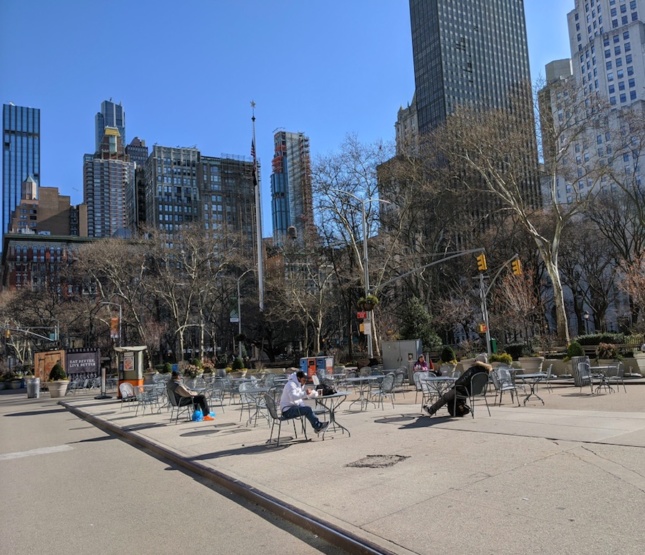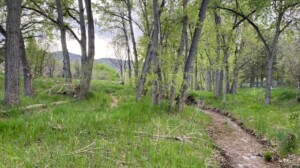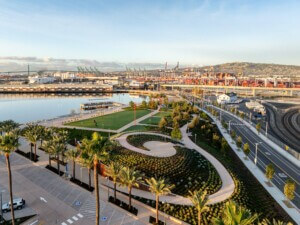For those living in heavily impacted urban areas, life during the novel coronavirus pandemic has been spent largely confined indoors, housebound and isolated, disconnected from the typical physical places where city-dwellers tend to congregate en masse when not working. Bars, restaurants, gyms, theaters, and on have all been closed.
Outdoor public space, on the other hand, is considered “safe” but with one key caveat: the concept of social distancing has to also be closely observed on city sidewalks, parks, beaches, and the like to help curb the spread of the virus. Otherwise, heading outside for some fresh and exercise as the weather improves—a much-needed balm for corona cabin fever—is rendered moot if it’s spent in close proximity to hundreds of others.
To help prevent overcrowding in popular parks, trails, and recreational areas (a major issue in places like Los Angeles and New York), some cities are embracing new approaches that enable residents to enjoy the outdoors but at more of a safe distance from the madding, potentially infected crowds.
Philadelphia has prohibited vehicular access along a four-mile stretch of Martin Luther King Jr. Drive, a generally busy riverside road within West Fairmount Park that, under normal circumstances, is closed to vehicles only during limited hours on weekends. Philadelphia Mayor Jim Kenney’s office said in a press release that pedestrianizing the street full-time is “in the interest of facilitating social distancing among trail users.” Kenney’s office went on to note that the city “strongly encourages residents to stay indoors as much as possible” but “recognizes that physical activity is important to well being.”
We hope you’re finding some solace and beauty in Philly parks at this time. Here’s a photo of beautiful magnolia trees 🌸 in bloom along MLK Drive yesterday. It’s closed to vehicles 24 hours/day to allow for more social distancing. 📸 Share your photos by tagging #myphillypark! pic.twitter.com/YC6GpWIbGo
— Fairmount Park Conservancy (@myphillypark) March 22, 2020
In San Francisco, pedestrian advocacy groups are pressing the city to close off certain streets to vehicular traffic, already dramatically reduced in numerous on-lockdown cities, so that pedestrians can exercise and get around while at a remove from their fellow fresh air-seekers. The idea has garnered support from local officials although no plans have been formalized.
As reported by the San Francisco Examiner, safe streets advocate Patrick Traughber has even crowd-sourced a number of streets—Divisadero Street, Valencia Street, John. F. Kennedy Drive in Golden Gate Park, and Haight Street among them—that would particularly benefit from 24/7 traffic closures during the pandemic.
“You absolutely have to walk in the street to pass people,” said Traughber. “Since the streets have car traffic, it’s a dangerous situation. It feels like we could convert some of the road capacity to walk while the car traffic is down.”

Yesterday, New York City Mayor Bill de Blasio also announced a four-day street closure test-run in Queens, Manhattan, the Bronx, and Brooklyn. The shuttered streets, totaling 1.6 miles of over 6,000 miles of roadway in the city, include Park Avenue between East 28th and East 34th streets in Midtown Manhattan; Bushwick Avenue from Johnson Avenue to Flushing Avenue in Williamsburg, Brooklyn; 34th Avenue from 73rd Street to 80th Street in Jackson Heights, Queens; and Grand Concourse between East Burnside and 184th Streets in the Fordham Heights section of the Bronx. Staten Island has been excluded from the pilot.
“Everyone wants to make sure there are spaces for folks to get their exercise, to get fresh air, there must be enforcement,” said de Blasio. “It has to be places the NYPD and other agencies can enforce effectively.”
While limiting vehicular traffic on New York City streets—even if just limited stretches of them—is the long-held dream of safe street advocates, de Blasio’s plan has been greeted with a mixed reception.
Some have criticized the limited nature of the scheme and the fact that it will only be enforced nine hours a day from 10:00 a.m. through 7:00 p.m. Because the number of street sections being closed off to traffic is minuscule compared to the total amount of roadway in the city that could potentially be made off-limits to cars during the duration of the pandemic while not interfering with the movement of emergency vehicles, there are concerns that the sheer number of people congregating in the sparse car-free streets could devolve into an out-of-control health hazard. Simply put, some think de Blasio, who also has temporarily banned contact sports like basketball at city parks and threatened to shut down playgrounds, should have thought much, much bigger.
I’m not a city planner, but if you want to do this, you have to close a LOT of streets over long distances, in a bunch of neighborhoods. And if you need to do a pilot to figure out logistics, do it quickly and quietly—not four days of closures for nine hours a day over a weekend.
— Angus Johnston (@studentactivism) March 26, 2020
I present without comment @NYCMayor‘s visionary plan to grant open street access during the pandemic to all neighborhoods across the five boroughs. pic.twitter.com/KQS5CHvDGp
— Will, P.E. (@wjfarr) March 26, 2020
Outside of streets closing off to traffic, other outdoor venues are making themselves more available to cooped-up residents who want to be outside but are wary of the overcrowding seen in parks large and small.
Brooklyn’s sprawling, stunning Green-Wood Cemetery, for example, plans to extend its public hours starting in April in order to accommodate an influx of visitors. The historic 500-acre cemetery, located not too far from Prospect Park, hopes that its strict existing rules prohibiting activities like dog-walking, bicycling, and jogging will make it a more attractive destination to social distance-observing New Yorkers simply looking to enjoy long, quiet solo walks.
“Green-Wood was designed to be a different kind of experience,” Lisa Alpert, Green Wood’s vice president of development and programming, told the New York Times. “It’s a more contemplative, less recreational one, intended to connect people with nature, and we are especially happy now to serve as a green space for people to get away.”
As Sara Bronin, an attorney, architect, and advisor to the National Trust for Historic Preservation wrote in a recent op-ed for the Philadelphia Inquirer, now is the time for urban green spaces—specifically spacious urban green spaces that aren’t as easily prone to overcrowding—to shine. After all, many of America’s great historic city parks and rural cemeteries like Green-Wood were expressly created in the mid-19th and early 20th centuries as places for city dwellers to escape cramped residential neighborhoods and the rampant infectious diseases such as tuberculosis that spread through them. “The scale of these carefully-designed grand parks, and the ambitions of their designers, far surpass the vision behind the small-minded ‘pocket parks’ local leaders seem to favor today,” opined Bronin.
“Other communities should restore the grand historic parks that are getting us through the current crisis and will serve as vibrant places of social cohesion long after COVID-19 is conquered,” continued Bronin, singling out Philadelphia and Hartford, Connecticut, as two cities dedicated to preserving its historic park infrastructure. “Special attention should be paid to equity and ensuring that investments are spread fairly across neighborhoods. Let’s do what we can to renew our commitment to those places that are giving so much right now to our bodies, hearts, and spirits.”











